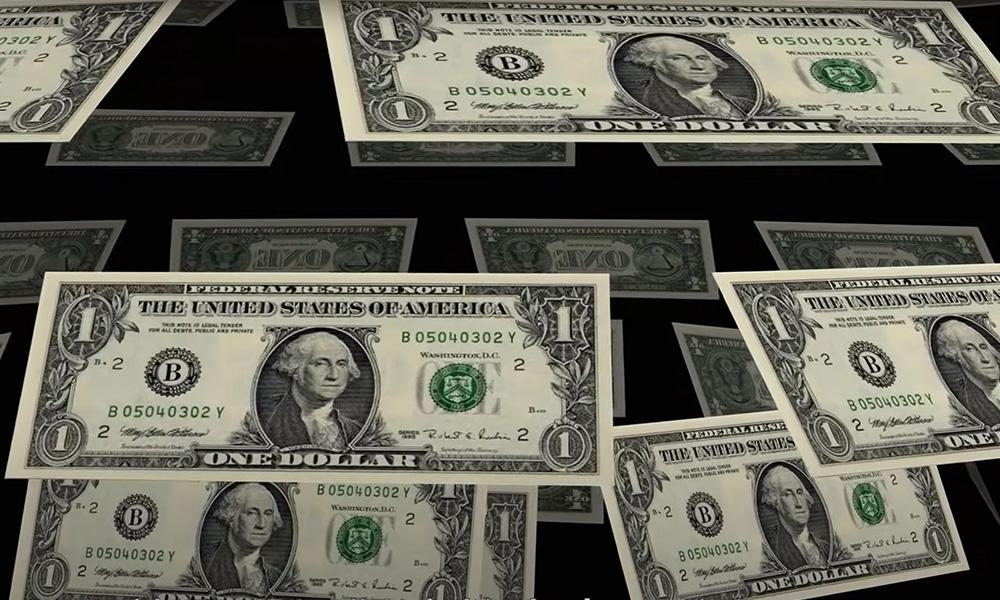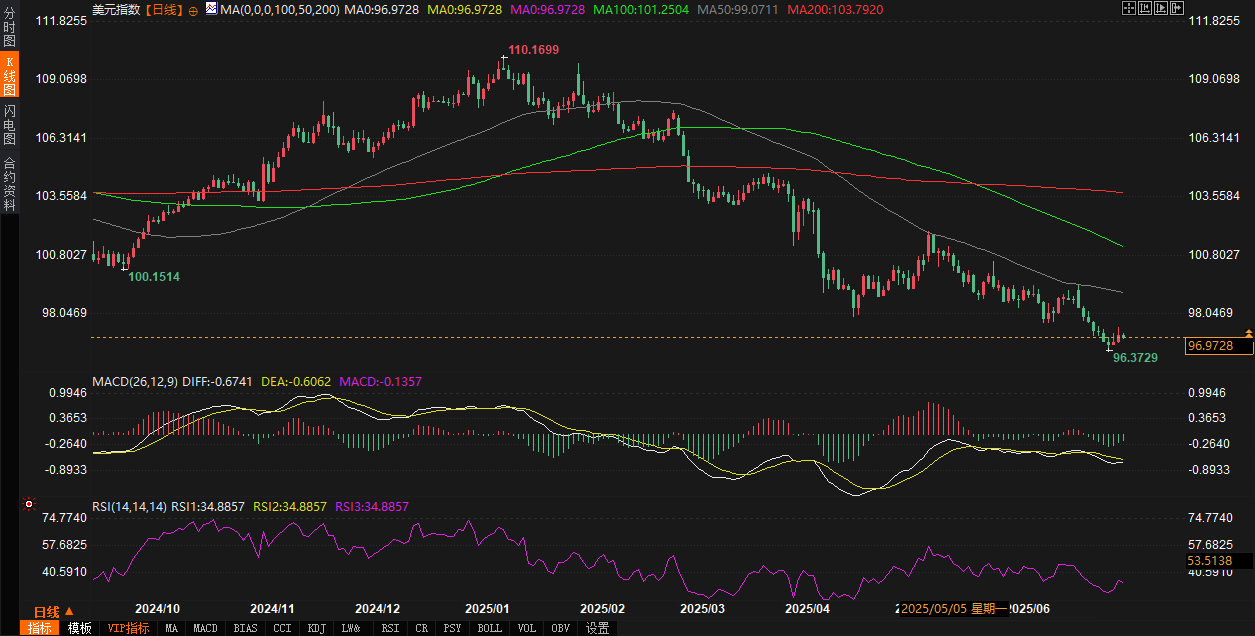The US dollar index is in danger of reaching the 97 mark! Tax reform "ammunition" VS tariff "airstrike", who will occupy the commanding heights in the long-short duel?
2025-07-04 20:35:31

Fundamental analysis: Dual pressure from tariff rhetoric and tax reform bill
Recently, the trend of the US dollar index has been driven by multiple fundamental factors. First, Trump's tariff remarks continue to ferment, and market concerns about the outlook for global trade have intensified. According to the latest news, Trump announced on Thursday that he would send tariff notification letters to multiple trading partners. Although the specific details have not yet been disclosed, this move has undoubtedly increased market uncertainty. Tariff remarks have led to investors' expectations of slowing global economic growth and rising inflation, and risk aversion has spread in the market. Against this background, the attractiveness of the US dollar as a traditional safe-haven asset has been somewhat suppressed, especially when the market's uncertainty about the US economy itself has increased.
Meanwhile, the tax reform bill promoted by Trump has become another focus of market attention. The bill, which is expected to increase the US debt by $3.3 trillion, has been passed by Congress and may be signed by the president today. The bill extends the tax cuts that were originally scheduled to expire and adds tax breaks for tips and overtime pay. Analysts from well-known institutions pointed out that in the short term, the bill may inject vitality into the US economy by stimulating consumption and investment, thereby providing some support for the US dollar. However, in the long run, the high debt burden brought by the bill has caused market concerns. The current US debt accounts for 6.5% of economic output, and the fiscal deficit has not improved even in the economic growth stage. The bill's cuts in medical insurance and potential impacts on labor supply (such as increased repatriation expenses) may further limit the US economic growth potential. These factors make the market lack confidence in the long-term strength of the US dollar.
In addition, the continued tension between Russia and Ukraine has also added geopolitical risks to the market. Although the US dollar usually benefits when risk aversion heats up, the current geopolitical uncertainty and tariff rhetoric have made the market more inclined to wait and see rather than bet on the US dollar unilaterally. It is worth noting that the holiday effect further amplifies the limitations of market volatility. The US market was closed for the Independence Day holiday, and the trading volume decreased significantly. The intraday volatility of the US dollar index was limited, showing typical holiday market characteristics.
Technical analysis: key moving average support and indicator signals
From a technical perspective, the current correction trend of the US dollar index has been clearly reflected in the technical indicators. The daily chart shows that the US dollar index has fallen below the 50-day moving average (99.0712) and is further away from the 100-day moving average (101.2505) and 200-day moving average (103.9720). This shows that the overall downward trend of the US dollar index has not been reversed since the beginning of April, and it is still in a bearish pattern in the short term. The current quote of 96.9811 is at a recent low, indicating that the market lacks bullish momentum for the US dollar.
The MACD indicator further confirms this trend. The current MACD (26, 12, 9) shows that DIFF is -0.6740, DEA is -0.6063, and the MACD value is -0.1359. The fast and slow lines are both below the zero axis, and the negative gap between DIFF and DEA is widening, indicating that the short-term momentum is still increasing. The RSI (14) indicator is 34.8420, close to the oversold area, suggesting that the US dollar index may have some room for rebound in the short term, but the overall trend is still weak.

From the K-line pattern, the US dollar index failed to stabilize after hitting a high of 97.40 on Thursday, and then fell back quickly, indicating heavy pressure from above. Combined with the trading volume analysis, the low trading volume during the holiday period reduces the possibility of breaking through key points. In the short term, the US dollar index is likely to fluctuate in the range of 96.50 to 97.50. The support level below can be focused on around 96.80. If it falls below this level, it may further test the psychological barrier of 96.00; the resistance level above is in the range of 97.00 to 97.40, which is difficult to break through.
Market sentiment and institutional views
In terms of market sentiment, traders are generally cautious about the short-term trend of the US dollar index. A senior trader said: "The US dollar is under the double pressure of tax reform and tariff rhetoric in the short term. The low trading volume during the holiday has amplified the uncertainty of fluctuations. It is recommended to pay close attention to the market reaction after the opening of Monday." Another user pointed out that after the US dollar index fell below 97.00, the short-term technical signals became more and more obvious, and it is difficult to have a trend market in the short term.
The views of well-known institutions also reflect similar differences. Analysts from one institution pointed out that the passage of the tax reform bill may boost market expectations for US economic growth in the short term, but high debt and potential contraction in labor supply will weaken the long-term appeal of the US dollar. Another institution emphasized that the potential impact of tariff rhetoric on the global supply chain may further push up inflation expectations, thus posing a complex impact on the US dollar - it may be supported in the short term due to safe-haven demand, but high inflation and high debt may weaken the US dollar's reserve currency status in the medium term.
Future Trend Outlook
Looking ahead to the next week, the trend of the US dollar index will be highly dependent on the further evolution of fundamental news and technical breakthroughs. Fundamentally, the formal signing of the tax reform bill and the performance of subsequent economic data (such as inflation, employment, etc.) will be key. If the stimulus effect of the bill is evident in the short term, the US dollar may gain some support at a low level and try to rebound above 97.00. However, if market concerns about high debt and tariff rhetoric continue to heat up, the US dollar index may further fall to 96.00 or even lower. In addition, the development of the situation between Russia and Ukraine and the change in risk appetite in the global market will also have an important impact on the trend of the US dollar.
Technically, the current weak pattern of the US dollar index is difficult to reverse in the short term. The RSI indicator is close to the oversold area, suggesting that there may be a technical rebound in the short term, but unless it can effectively break through the 50-day moving average (99.0712), the rebound space is limited. Traders need to pay close attention to the gains and losses of the 96.80 support level and the 97.40 resistance level. If it falls below 96.80, the bearish trend will be further confirmed; if it breaks through 97.40, it may open up space and test the 98.00 mark.
In summary, under the dual pressure of fundamentals and technical aspects, the US dollar index is likely to maintain a range-bound pattern in the short term. Traders should remain patient and wait for the market trading volume to recover after the holiday and for key news to become clearer in order to capture a clearer trend direction.
- Risk Warning and Disclaimer
- The market involves risk, and trading may not be suitable for all investors. This article is for reference only and does not constitute personal investment advice, nor does it take into account certain users’ specific investment objectives, financial situation, or other needs. Any investment decisions made based on this information are at your own risk.










